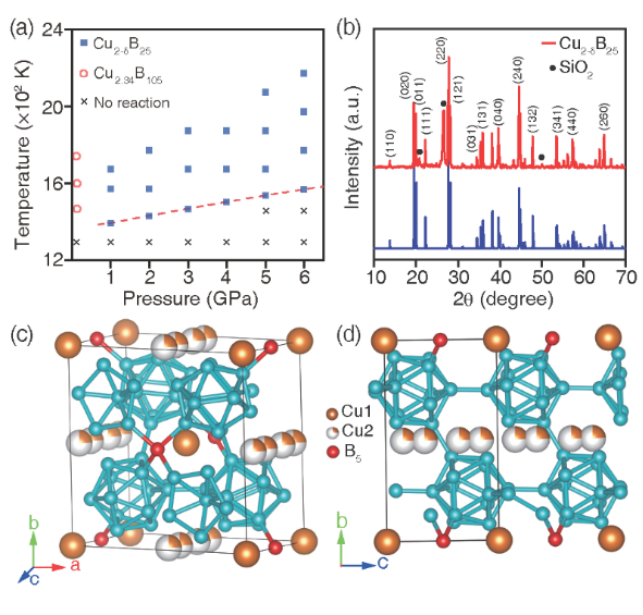The team led by Academician Tian Yongjun from the Center for High Pressure Science at YSU, in collaboration with researchers at home and abroad, successfully synthesized a new ceramic material composed of copper and boron elements that are immiscible via a high-temperature and high-pressure melting method. The related achievements have been published in the world’s top physics journal Physical Review Letters under the title Hard Copper Boride with Exceptional Conductivity. Link: https://link.aps.org/doi/10.1103/PhysRevLett.133.136301.


Figure 1 P-T phase diagram, XRD spectrum and diagram of associated crystal structures of copper-doped boron compound
Featuring strong wear resistance, corrosion resistance, high temperature resistance and high hardness, metal borides, a kind of versatile ceramic material, have been widely used in chemical, pharmaceutical, metallurgical, national defense and other sectors. Although boron can react with most metals at high temperature, no reports on Group IB (copper, silver, gold) metal borides have been found. There are only a few reports on the solid solutions of copper (Cu) and boron (B), which are representatives of immiscible elements, for example, CuB~23 and CuB~28. This is because boron has a similar electronegativity with these metals but a quite different atomic radius, making charge transfer between them difficult, and thus no compounds with a precise stoichiometric ratio may be produced. It was not until 2021 that Zhou Xiangfeng, Xu Bo, et al., have successfully synthesized 2D copper-doped boron compounds Cu8B14 for the first time through Molecular Beam Epitaxy (MBE) technique [Fundam. Res. 1, 482 (2021)], proving that copper atoms and boron atoms can form chemical bonds under extreme conditions. Inspired by this, Zhou Xiangfeng, Xu Bo, Tian Yongjun, et al., synthesized and characterized a new 3D copper-doped boron compound Cu1.97B25 under high temperature and high pressure, which was found to be a new ceramic material that possesses both high hardness and exceptional conductivity. It has a measured Vickers hardness of ~27 GPa and a conductivity of up to 105S/m at room temperature, which is the highest conductivity among the B12 icosahedron-based borides. Moreover, Cu1.97B25 reveals a metal-insulator transition under low temperature and normal pressure, or low temperature and high pressure. A p-n conduction type transition occurs at around 30 GPa. Experiments have shown that these are caused by electronic phase transition rather than structural phase transition. Therefore, the novel copper-doped boron compound not only has excellent physical properties at normal pressure, but also exhibits rich quantum behaviors under extreme conditions. Thanks to the exceptional electrical conductivity and the intrinsically low thermal conductivity of the 3D boron grid, promising applications of this material may be expected in the field of thermoelectric conversion.
This work was financially supported by the Basic Science Center Program of the National Natural Science Foundation of China, the National Science Fund for Distinguished Young Scholars, the National Key Research and Development Program of China etc., and applications for utility patents for the achievements have been submitted. The co-first authors of the paper are Huang Mingxing, a doctoral student from the School of Science at YSU, and Fan Changzeng from the School of Materials Science and Engineering. The corresponding authors are Zhou Xiangfeng and Tian Yongjun.